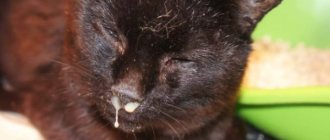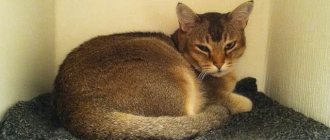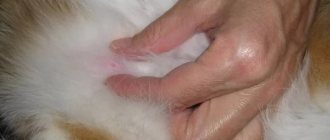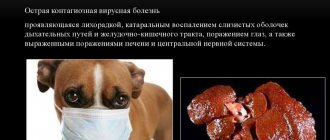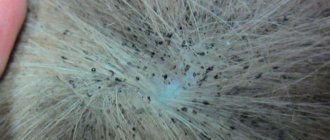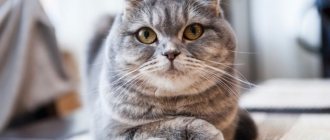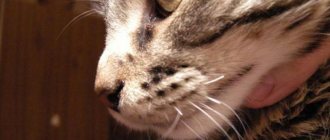What is peritonitis and why does it develop in cats?
Peritonitis (from the Latin peritoneum - peritoneum, -itis - inflammation) is an inflammation of the serous membrane (peritoneum), which covers the internal organs located in the abdominal cavity of the animal.
Causes of peritonitis in cats:
- Failure of the immune system. The disease most often affects young cats, under 2 years of age, as well as older animals (over 10 years old). In kittens and young cats, the immune system is still imperfect and is not ready to withstand severe infections. At older ages, the activity of the immune system decreases and loses the ability to fully protect against infections.
- Living outdoors or with a large group of animals. More often, the disease affects cats that live on the street, in nurseries, as well as pets that live in private homes and can go for walks. Such cats are more likely to become infected with pathogens.
- Poor pet care. Poor nutrition or failure to comply with animal hygiene rules.
Diagnosis of peritonitis
With diagnostics, not everything is as easy as we would like; an autopsy will give its own unambiguous answers, but this will not make it any easier for the owner. Therefore, the question of how to determine in a timely manner why an animal is sick is relevant.
Blood biochemistry also has its own nuances. Deviations revealed by diagnostic tests are characteristic of liver or kidney damage.
It is possible to register viral peritonitis in a cat intravitally by taking a laboratory analysis of a sample of fluid from the peritoneum. The Rivoli method is used to determine total protein content. In most cases, the protein from the straw-colored exudate will coagulate in the syringe and the liquid will thicken.
global $ads_google; //data-ad-slot=”2475549904″ $ads_google = empty($ads_google) ? false : true; ?> if ($ads_google == false) {?>
$ads_google = true; ?> } ?>
If it is ascites, then the liquid will be almost transparent and not viscous due to the lack of fibrin. But this method is objective only for the wet form of FIP, although the dry form is also characterized by fibrinous inflammation with fibrin flakes on the surface of the internal organs.
If the stage of the disease has advanced far, the internal organs will begin to fuse with each other, forming adhesions. The appearance of the organs is dystrophic and deformed.
What tests are performed?
If you suspect this insidious disease, you will need to conduct a series of tests. Can't do without:
- biochemistry and clinical blood tests;
- Ultrasound of the abdominal organs;
- PCR for coronavirus by taking a smear or collecting fluid from body cavities;
- blood for antibody titer using ELISA;
- blood protein electrophoresis.
Based on the data obtained, the veterinarian will draw conclusions and predictions.
Types of disease
The disease has two main classifications.
Classification due to the development of peritonitis
According to etiology (reason for development), peritonitis is divided into:
- infectious nonspecific;
- infectious postoperative;
- infectious specific (viral);
- invasive;
- non-infectious.
Infectious nonspecific peritonitis
The disease develops as a result of injury to the animal, which is accompanied by a violation of the integrity of the abdominal wall and/or damage to internal organs. This can happen during street fights, road accidents, falls from a height, or eating inedible sharp objects (buttons, thorns, etc.).
An injury sustained by a cat in a fight can cause infectious nonspecific peritonitis.
When internal organs are damaged, their contents (stomach, intestinal) or blood (due to vascular damage) are released into the abdominal cavity. These substances lead to the release of pathogenic microflora into the abdominal cavity and irritation of the peritoneum, as a result of which an active inflammatory process develops - peritonitis.
Inflammatory diseases of the liver, kidneys, and intestines are also the cause of the development of infectious nonspecific peritonitis. The pathological process from these organs can move to the peritoneum and lead to the development of peritonitis.
Infectious postoperative peritonitis
It develops as a complication after surgical interventions due to non-compliance with the rules of asepsis and antisepsis (sterility conditions) during surgery. Most often, pathology occurs after sterilization of a pet.
Therefore, it is necessary to take the choice of a clinic for sterilization seriously, by reading online reviews about the institution or consulting with friends who have visited this clinic.
Infectious specific (viral) peritonitis
The cause of the disease is infection of a cat with coronavirus (FECV - Feline Enteric Coronavirus or FIPV - Feline Infectious Peritonitis Virus). Most cats have FECV in their bodies, but it lies dormant and does not cause disease. When exposed to unfavorable conditions (injuries, severe concomitant diseases) or weakened immunity, it first causes inflammation of the intestines (enteritis), and then can mutate and cause the formation of peritonitis in the cat.
In other cases, a pet may immediately become infected with the FIP virus, which will lead to the development of peritonitis.
Video: feline viral peritonitis (FIP)
Invasive peritonitis
The disease occurs due to the proliferation of worms in the cat’s body, which can close the intestinal lumen and lead to its perforation (rupture).
Non-infectious peritonitis
In this case, the cause of the development of the pathological condition is the influence of thermal or chemical (acid-containing substances) factors. The process is non-infectious, since the cause of the formation of the disease in this case is external, but the possibility of the addition of viral or bacterial flora in the future cannot be ruled out. Then the disease becomes infectious.
Classification according to the form of the disease
According to the form of the disease, it is divided into:
- exudative (wet);
- proliferative (dry).
Exudative form of the disease
More than 70% of cats suffer from this form of peritonitis. After the virus enters the animal’s body, it begins to actively divide and enters the blood, as a result of which the normal functioning of the vascular walls is disrupted. Through the wall of blood vessels, fluid from the bloodstream begins to seep into the tissues and accumulate in the free cavities of the body: abdominal, pleural (around the lungs), pericardial (around the heart).
More often, fluid accumulates in the abdominal cavity and leads to ascites (externally this is manifested by a significant increase in the size of the abdomen)
Based on the nature of the fluid, exudative peritonitis is distinguished:
- purulent (formed in the presence of bacteria);
- serous (yellowish liquid formed from blood due to its leakage through the vascular wall);
- fibrinous (a protein substance of a whitish-gray color);
- hemorrhagic (blood);
- fecal;
- bile.
Often there is a combination of several types of fluids, for example, serous-fibrinous or fibrinous-purulent wet peritonitis.
The wet form of peritonitis develops acutely and is more malignant than the dry form.
Dry form of the disease
It is manifested by the development of inflammatory foci - granulomas in various organs of the animal (liver, intestines, kidneys, lymph nodes, etc.). An inflammatory focus that has developed in one organ is a source of chronic infection and promotes the spread of inflammatory cells through the bloodstream to other organs of the cat. Granulomas lead to disruption of the normal functioning of the affected organs and the inability to perform their functions, as a result of which all metabolic processes in the animal’s body are disrupted, which can lead to multiple organ failure.
The course of the disease is chronic, the symptoms of the disease develop over several months, so the presence of the disease in a pet is difficult to recognize.
In some cases, the disease can change from one form to another: from exudative peritonitis (subject to timely treatment) it turns into dry peritonitis, which prolongs the life of the animal from several months to a year.
Polyprenylphosphates and feline viral peritonitis (FIP)
Feline infectious peritonitis (FIP - feline infectious peritonitis) as an independent disease is known relatively recently; the virus that causes it was identified only in 1977. It has been established that the disease is caused by coronaviruses (FIPV), which multiply at the tips of the villi of the intestinal epithelium or in the mesenteric lymph nodes after infecting other cells of the immune system.
Appearing in Russia only in the mid-1990s, coronavirus infections quickly became a real scourge for cat nursery owners. In approximately 5% of cases, cats infected with coronaviruses develop infectious peritonitis - a disease that is rightfully considered one of the most complex, dangerous and insidious in felinological veterinary practice.
The disease can occur rapidly (acute form) or long-term (chronic form); transmission of the virus from an apparently healthy animal to other individuals with reduced immunity (kittens born from an infected mother) has been confirmed. At risk are young animals under the age of 2 years, as well as cats with reduced immunity (elderly, weakened by other diseases). Based on clinical signs, dry and wet forms of the disease are distinguished. The dry form of the disease is characterized by a long, gradual development: the animal experiences a depressive state, rapid weight loss in the presence of appetite, and rapid development of signs of damage to other organs (usually the liver, kidneys, eyes, and nervous system). If it is possible to establish the presence of coronavirus in a cat’s body at this stage and prescribe treatment, the chances of a favorable outcome are usually greater. In cases where the pathogen could not be identified or such studies were not carried out, further development of the disease occurs with a transition to the wet form. The animal experiences loss of appetite, depression, enlargement of the abdomen due to the accumulation of fluid (effusion) in the abdominal cavity, shortness of breath, and cardiac arrhythmias. At this stage of the disease, cure is impossible, however, there are cases of the disease being transferred to the stage of remission (no signs of the disease).
Since the discovery of the root cause of feline viral peritonitis, veterinarians around the world have been looking for effective ways to treat it. It is curious that almost simultaneously in Russia and the United States, research began on the use of polyprenyl phosphates in the treatment of coronavirus infections. Independently, data have been obtained to suggest that the inclusion of drugs in this group of drugs in the treatment regimen is justified.
Polyprenyl phosphates (PPP) are the active ingredient in two of our veterinary drugs: Gamapren and Fosprenil. The differences between these agents lie in the concentration (in Gamaprene 0.5%, in Fosprenil 0.4%) and the raw materials from which PPF is obtained. They both have a direct antiviral effect against the causative agent of infectious peritonitis (disturb the synthesis of viral proteins in the affected cell), and also have a general stimulating effect on the production of interferons and other cytokines under conditions of macrophage activation. Treatment of the dry form of the disease is most effective, because with a weak cell-mediated immune response, when there is a massive proliferation of coronavirus particles in macrophages, the disease passes into the wet form, and timely activation of macrophages and an increase in the production of early key cytokines (interleukin-12, interferon-alpha) avoids the transition of the disease to the wet form and achieve remission. Treatment of the wet form of peritonitis is more complex, however, even here, the use of drugs containing PPF increases the chances of a favorable outcome.
Currently, the following regimens have been developed for the use of Gamapren and Fosprenil in the treatment of feline viral peritonitis (FIP) as part of complex symptomatic therapy.
— for the prevention of the wet form of FIP, as well as to reduce antibody titers in cases of diagnosed coronary artery disease in cats, Gamapren is used by injection at a dose of 1-1.5 ml per animal, a course of 2-3 weeks, 1 injection with an interval of 2 days, or by drinking in those same dosages daily, 1 time per day for 2-3 weeks.
— for the treatment of the dry form of FIP, Gamapren is prescribed by injection in doses of 1-2 ml per animal for a course of 5-7 days, 2 times a day; if the dynamics are positive, they switch to a preventive course. Fosprenil is used by injection in doses of 0.5-0.8 ml/kg 2 times a day for 5-7 days, or administered in doses of 3-5 ml per animal 3-5 times a day. If the dynamics are positive, they switch to 2 or single administration of Fosprenil in the next 2-3 weeks.
— for the treatment of the wet form of FIP, Gamapren is used by injection or drinking 2-3 times a day in doses of 1-2 ml per animal for 7 days; if the dynamics are positive, they switch to 1-2 single administrations. Fosprenil is used comprehensively: injection at a dose of 1.5-2 ml per animal and drinking at a dose of 3-5 ml per animal up to 5-6 times a day, administration of a warm solution of Fosprenil in the form of an enema is also indicated, intraperitoneal administration of Fosprenil with saline is also possible. in a 1:1 ratio (about 20 ml of the mixture) after draining the ascites fluid.
— the greatest effectiveness was achieved with fractional administration of drugs (3 times a day or more), it is possible to combine Gamapren and Fosprenil in one regimen.
- animals that have achieved remission must undergo lifelong preventive courses of treatment with Gamapren or Fosprenil at a dose of 1-1.5 ml per animal for 10-14 days with an interval of 6-10 or 12 months. To reduce titers of antibodies to coronovirus in the blood serum, clinically healthy animals are also recommended to undergo preventive courses of medications at intervals of 12-18 months, depending on the results of a virological study.
These recommendations are the generalized experience of veterinarians from Russia, and the article also used some data from publications by AlfredMLegendre (USA). We continue to collect case reports on this and other topics.
Veterinarian – Zaripova Tatyana Evgenievna
The article was written for the website Dobropesik.ru.
Materials posted on this page may be reprinted on the Internet only if a hypertext link to our website is placed:
Ways of infection with peritonitis
Scientists identify three ways of transmitting the disease:
- fecal-oral;
- airborne;
- from mother to fetus.
The main route of transmission is fecal-oral, that is, through the mouth.
The virus is released in the feces, urine and saliva of an infected animal into the environment, and then transferred to soil and plants. That is why animals that have frequent contact with the street and street cats are susceptible to infection. Also, the causative agent of the disease may be present in low-quality or poorly processed food products, or in dirty water.
A pet can become infected while playing with the owner’s outdoor shoes or objects brought from the street.
Even domestic cats that never go outside can become infected with peritonitis from objects brought into the house by the owner, including shoes.
The second most common route of infection is airborne transmission. In cats that have frequent contact with other animals, the likelihood of developing the disease increases significantly. Domestic cats can become infected at exhibitions if they have close contact with infected animals.
The third route of infection is transmission of the virus to a kitten from an infected mother while feeding it with milk. However, these cases are extremely rare.
Genetically determined susceptibility - some cat breeds are likely to be more susceptible. This suggests that there is a genetic predisposition to the development of infectious peritonitis, possibly related to the major histocompatibility complex gene.
Karpetskaya N.L., veterinarian
https://www.elite-line-cats.com/%D0%BA%D0%BE%D1%80%D0%BE%D0%BD%D0%B0%D0%B2%D0%B8%D1%80 %D1%83%D1%81/
FIP treatment
Since in most cases the disease is fatal, supportive therapy is used. Symptomatic treatment includes the use of the following groups of medications:
- antiviral drugs;
- antibiotics;
- cardiotonics;
- immunostimulants;
- diuretics;
- corticosteroids;
- potassium-sparing agents;
- vitamins.
In severe cases, blood transfusions are prescribed.
If there is a large accumulation of fluid, the doctor makes a puncture
If fluid accumulates in the abdomen or sternum, the veterinarian will begin to drain it. This measure brings only temporary relief to the animal, since the transudate is collected again. In this case, beneficial elements are washed out of the body, especially potassium. As a result, the more often excess fluid is removed, the more harm is caused to the body.
Coronavirus that has not yet mutated into FIP can be treated. When diagnosing infectious peritonitis, the doctor recommends euthanasia.
New trends in treatment
American specialists have achieved success in treating the dry form of FIP. 20% of animals showed an improvement in their physical condition after taking Polyprenyl immunostimulant.
Russian scientists have succeeded in combating the wet form of infectious peritonitis by developing Fosprenil . The heated liquid was injected into the peritoneum after pumping out the transudate. Rectal and oral forms of administration were also used. 2 weeks after taking the drug, progressive remission and stabilization of vital signs were observed. During testing of the drug, 6 animals were completely cured.
Immunomodulator "Fosprenil" - an innovative drug for the treatment of FIP
Symptoms of the disease in cats
Manifestations differ depending on the form of the disease.
Symptoms of wet peritonitis:
- loss of appetite, up to complete refusal of food;
- significant loss of body weight;
- decreased activity (the cat stops playing, running, and spends more time just lying or sleeping);
- increase in abdominal size (ascites);
- the cat reacts painfully to touching its stomach;
- prolonged increase in body temperature;
- convulsions may occur;
- in severe cases - shortness of breath even with light exertion;
- bowel dysfunction (constipation is more common, diarrhea may be less common).
Symptoms of dry peritonitis:
- decreased appetite;
- gradual weight loss;
- impaired urine output (incontinence);
- bowel dysfunction (constipation is more common, diarrhea may be less common);
- apathetic or unusual behavior for a cat;
- convulsions;
- impaired coordination of movements;
- yellowness of the skin and mucous membranes;
- eye diseases (opacity of the vitreous body, cornea, damage to the choroid - uveitis), which leads to decreased or loss of vision;
- in severe cases - paralysis of the limbs (usually the lower ones).
I believe that even at the slightest suspicion that a cat is developing such a dangerous disease as peritonitis, you should immediately contact a veterinarian. It is better to be an “overly caring” owner than to then watch the suffering of your pet.
Incubation period, forms and symptoms
From the moment the virus enters the body until the first signs of illness appear, it can take from 2-3 weeks to six months.
It all depends on the dynamics, as well as the specific form of peritonitis. Adding to the complexity is the fact that in 75% of cases, symptoms do not appear at all, which complicates further treatment.
Did you know? Cats' ears have 20 muscles, which gives them unique mobility.
Exudative and proliferative forms are considered more expressive, which are worth dwelling on in more detail.
The exudative (“wet”) scenario is associated with the production and release of a significant volume of fluid entering the abdominal or chest cavity. This process is easy to notice:
- shortness of breath begins (if the substance enters the chest cavity, thereby giving rise to pleurisy);
- the abdomen may also become enlarged; in severe cases, up to 1 liter of exudate can get there;
- all this is accompanied or begins with loss of appetite, lethargy or weight loss.
Such characteristic symptoms only emphasize the acute course of the disease and its danger.
A more gradual chronic course is characteristic of the proliferative (dry) form. In such cases, fewer vessels are affected. Although this does not make it any easier for the pet - with this development of events, he may experience:
- damage to the eyes, in particular the retina and iris; it happens that dry plaque is clearly visible under the eyelids;
- enlarged lymph nodes;
- increased skin sensitivity;
- causeless and frequent changes in mood;
- “failures” of the nervous system - impaired coordination of movements, manifestations of paresis of the hind limbs;
- fever;
- problems with breathing, liver and kidney function;
- Sick kittens are noticeably stunted in growth.
Important! An increase in temperature is just an indirect sign, characteristic of many diseases.
These symptoms, found in cats, and indicating that infectious peritonitis occurs in a proliferative form, are considered the most dangerous. This is due to irreversible changes in the body.
Diagnosis of disease in cats
Diagnosis of peritonitis is carried out in several stages:
- Anamnesis collection.
- Carrying out an examination of the animal.
- Laboratory examination.
- Instrumental examination.
History taking
The veterinarian finds out what symptoms alerted the owner of the pet, where it was taken from (from the street, a nursery or from other owners). Also, whether the animal had any operations and if so, when. An important issue is the cleanliness of the habitat, hygiene and the quality of the animal’s diet. And also whether there was contact with a large group of animals recently.
Carrying out an inspection
The doctor listens to the pet’s lungs, palpates the abdomen, measures body temperature and carefully examines the skin.
Laboratory examination
First of all, a blood, urine and stool test is taken. However, these methods are nonspecific and will only help identify the inflammatory process.
To detect the pathogen, special blood tests are performed:
- PCR (polymerase chain reaction, detects the presence of viral DNA in the animal’s body).
- ELISA (enzyme-linked immunosorbent assay, determines the concentration of antibodies to the causative agent of the disease).
- ICA (immunochromatographic analysis, rapid analysis for the detection of antibodies or antigens of the virus in the blood of a pet).
Instrumental examination
The veterinarian performs an ultrasound of the abdominal cavity, which can reveal the accumulation of fluid in the abdominal cavity, the presence of granulomas, and symptoms of intestinal inflammation.
During the examination, it is important that the animal lies quietly and practically does not move, then the doctor will be able to examine the abdominal organs as thoroughly as possible
If fluid is detected in the abdominal cavity, laparocentesis (puncture of the womb) is prescribed, during which fluid is taken from the abdominal cavity for analysis. If granulomas were identified during an ultrasound, they are biopsied and subsequently examined for the presence of the disease pathogen in the cells. In cases where the animal has shortness of breath, a chest X-ray is performed to identify fluid in the pleural cavity.
Signs, symptoms and diagnosis
Coronavirus infection can go undetected because it manifests as several days of diarrhea and sometimes vomiting. The duration of FIP disease can vary from a few days to several months, developing more quickly in the wet form than in the dry form. Both wet and dry forms can occur in the same cat at different times. Common symptoms for both forms of FIP include fever that is not relieved by antibiotics, loss of appetite, weight loss, and growth cessation in kittens. Peritonitis and excess fluid in the abdominal area are characteristic of wet (effusion) FIP.
Symptoms of FECV infection
FECV primarily affects the lining cells of the cat's small intestine and causes diarrhea (diarrhea). First, the virus enters the nasopharynx, hence the cough, snot, and hoarse voice. But all this may not happen. Then diarrhea begins, often with mucus and blood. Diarrhea lasts several days - about a week. Then everything goes away, no symptoms are observed, but the coronavirus is still present in the intestinal mucosa. The stool of such cats is not stable - diarrhea can spontaneously appear and disappear. The vast majority of cats eliminate the coronavirus: most of them within a month, others take 9-12 months. 13% of infected cats become lifelong carriers of FCoV. These cats constantly shed coronavirus in their feces, most of them have no clinical symptoms, but some develop chronic diarrhea. In 5-10% (according to various sources) of infected cats, the FECV virus mutates into FIPV, and the cat develops FIP. The mutation can occur due to stress, adverse environmental influences and other factors that weaken the cat’s immune system - vaccinations, previous diseases, surgical operations.
Symptoms of FIPV infection
The FIPV virus attacks macrophages (white blood cells), destroying them and thereby opening the way for infection in the tissues. The virus binds to antibodies, forming immune complexes that accumulate in the walls of small blood vessels, causing immune-mediated vasculitis. The disease then affects various tissues and organs. There are two forms of FIP—dry and wet (effusion). The initial symptoms of both dry and effusion FIP are quite non-specific and under normal conditions they are often ignored. The cat may periodically have a fever, lack of appetite, and sometimes have mild diarrhea, vomiting, anemia, dehydration, weight loss, and respiratory distress. FIP is called the “great imitator” because the disease can manifest itself in so many different ways. It can masquerade as a disease of the brain, spine, digestive system, eyes, cancer or cardiovascular disease. In the dry form, granulomatous lesions of various organs develop, and clinical symptoms reflect these disorders. The liver, lungs and kidneys are often affected, and the eyes (bilateral granulomatous uveitis, often accompanied by chorioretinitis) and the central nervous system may also be affected. Damage to the central nervous system results in a variety of neurological symptoms, including incoordination, increased muscle tone, paralysis, nystagmus, seizures and behavioral changes. Complications such as focal meningitis and encephalomyelitis are sometimes observed. Exudative (wet) FIP is the most severe clinical form, which quickly leads to death. It is characterized by effusion into the abdominal cavity. Along with this, in 20% of cases there are effusions into the pleural cavity and pericardium; the main clinical symptom in such cases is difficulty breathing. Weight loss, anemia, fever, vomiting, diarrhea are observed, and pericarditis and liver failure may develop. Jaundice may occur, especially in later stages of the disease. Damage to the eyes and central nervous system is observed in 10% of cases of effusion peritonitis. Death occurs within 1-2 months.
Treatment of the disease
If symptoms of the disease occur, you must immediately consult a doctor for a thorough examination, diagnosis and selection of the correct treatment tactics.
Under no circumstances should you treat your pet yourself, as this can harm it and aggravate the course of the disease!
For peritonitis, treatment should be comprehensive. Specific therapy that could cure the animal completely has not yet been developed. The goal of treatment is to stop the progression of the disease and prolong the life of your pet. The main areas of treatment include:
- antiviral drugs (for viral peritonitis) - Fosprenil or Enterostat;
- antibacterial agents (for bacterial peritonitis) - cephalosporins, penicillins, sulfonamides;
- corticosteroids - dexamethasone, prednisolone;
- vitamin therapy;
- infusion therapy;
- for fever - temperature-reducing drugs - analgin, paracetamol;
- if the animal is exhausted and it is impossible to take food orally, parenteral nutrition (nutrients are administered intravenously);
- painkillers;
- symptomatic therapy (maintaining the functioning of the heart and lungs).
If the cause of peritonitis is traumatic, surgical treatment is performed followed by drug treatment.
If a cat has developed wet peritonitis, laparocentesis is prescribed - a manipulation to pump out fluid from the abdominal cavity to alleviate the animal's condition. However, in most cases, the fluid accumulates again, so this method only alleviates the animal’s suffering for a short period of time.
If the pet can eat food, special fortified food is prescribed for animals with diseases of the gastrointestinal tract.
In case of acutely developed peritonitis or fluid accumulation in the abdominal cavity, cold compresses are indicated on the abdominal area.
Drugs and their dosages should be selected only by an experienced veterinarian based on the results of an examination of the animal.
Having studied and analyzed many sources, I did not find a single one that said that a cat is cured of viral peritonitis for life. Even in articles that indicated that peritonitis could be cured, further information was given that these animals subsequently experienced a relapse of the disease with an unfavorable outcome.
Causes of the disease
The cause of this pathology is considered to be coronavirus. First, the virus enters the epithelium of the respiratory tract. There its primary reproduction occurs. The spread of viral bodies is accompanied by a corresponding reaction from the immune system. This is manifested by the production of antibodies. The peritonitis virus then multiplies in the internal organs. This process leads to the formation of a large amount of inflammatory fluid. In addition, all organs and tissues of the body are damaged. Infectious peritonitis in cats often leads to inflammation of the ocular choroid and damage to brain tissue.
The main difficulty of the problem is the existence of many types of coronavirus. However, only some of them lead to infectious peritonitis. Most varieties of this virus only cause the development of dyspeptic symptoms in kittens. We are talking about short-term diarrhea. Nowadays, determining the danger of this virus is practically impossible.
According to some experts, sometimes a “virtually safe” coronavirus mutates into a deadly one. Therefore, there is no reliable way to protect a cat from the disease. This pathogen is characterized by stability and the ability to remain active for a long time. Conventional disinfectants and detergents lead to easy destruction of the virus.
Infectious peritonitis in cats manifests itself in a variety of ways. Therefore, diagnosing this disease is difficult. The clinical picture of this pathology may be similar to damage to the brain, spinal column, digestive tract, eyes, etc. To confirm the diagnosis, they use tests of blood and fluid that accumulates in the lung cavity and abdomen. In addition, a biopsy is recommended.
This pathogen is characterized by widespread distribution. However, the disease most often affects cats in nurseries, shelters and places with high animal overcrowding.
According to experts, there are a large number of cats in the population with antibodies to coronavirus. In this case, the development of pathology in these animals is facilitated by stressful situations and a decrease in immune defense. There is also evidence of the possibility of intrauterine infection in kittens.
Forecast
The prognosis for any form of peritonitis in an animal is extremely unfavorable. Even with early detection of the disease, mortality reaches 85–90%. In cases of late detection of the disease and late initiation of treatment, the mortality rate is up to 100%.
Exudative peritonitis develops acutely, is malignant and leads to the death of the animal in a short time. A favorable outcome is considered if during the course of treatment it was possible to transform wet peritonitis into dry, then the life of the animal is extended by several months, or even years.
Dry peritonitis develops slowly, so the animal may be sick for several years. Timely diagnosis and treatment, which will be aimed at maintaining the normal functioning of the affected organs and preventing further progression of the disease, will help prolong the life of the animal. However, cases of recovery remain extremely rare.
Treatment regimen
The main goal of FIP treatment is to prolong and facilitate the cat's life. It is impossible to completely rid the animal of the disease, but it can be allowed to live the remaining months or years without suffering.
As in humans, several groups of drugs are used - etiotropic to fight viruses, pathogenetic to slow down the development of the disease, symptomatic to improve well-being and prophylactic to avoid complications.
- Etiotropic therapy is aimed at slowing down the replication of the virus. Feline antiviral drugs are used - Enterostat, Fosprenil and others. The exact dosage is calculated based on the weight of the animal and its condition.
- Anti-inflammatory drugs of the steroid and non-steroidal series and drugs to enhance immunity are used as pathogenetic agents. Intravenous infusions of saline and nutrient solutions are also used. Their task is to maintain fluid balance in the cat’s body, to provide nutrition in case of decreased appetite or complete inability to eat from a bowl.
- To alleviate the animal's condition, vitamin preparations and painkillers are prescribed. Their administration allows the pet to feel relatively well and slow down the deterioration of the condition. To combat complications, antibiotics and drugs that support the functions of the kidneys, liver and lungs are used. They are prescribed as needed.
All medications are prescribed in the form of injections and droppers, so the cat will have to be treated at a veterinary clinic. The owner can give intramuscular injections at home. To do this, you need an assistant who will hold the cat. The injection site is just above the base of the hind paw. If the owner cannot perform the injection himself, it is better to entrust this to a veterinarian. Intravenous injections and infusions are only allowed in a veterinary clinic.
To alleviate the condition of effusion peritonitis, a therapeutic puncture is performed. Fluid is drained from the abdominal cavity through a special tube, giving the cat the opportunity to eat and move normally. This procedure must be carried out regularly. The danger of puncture is the risk of infection and the development of bacterial peritonitis, which leads to the rapid death of the pet.
Prevention of disease development
Basic measures to prevent disease in your pet:
- provide a rational and balanced diet (include vitamin complexes in the diet);
- maintain cleanliness in the animal’s habitat;
- carry out timely prevention of parasites (worms, fleas);
- avoid contact with large numbers of animals (especially street cats);
- undergo regular preventive examinations with a veterinarian;
- monitor the hygiene of the animal (bathe regularly using antibacterial shampoos, change the toilet in a timely manner and wash the bowl).
In America, a special coronavirus vaccine for pets was developed - Primucell FIP. The drug is administered through the nose (a few drops are instilled into the cat's nasal passages). Vaccination can only be carried out after the cat reaches 16 weeks of age. The bottom line is that a small dose of a weakened virus is introduced into the animal’s body, as a result of which the cat should develop immunity from the pathogen.
Whether to vaccinate is a matter of choice for each owner. I believe that if the cat is healthy and has not recently suffered any infectious diseases or operations, then vaccination should be carried out. No veterinarian can give a 100% guarantee that after this the cat will not become infected with FIPV, however, the introduction of small doses (especially weakened) of the virus will stimulate the immune system and form antibodies to the causative agent of the disease, which will significantly reduce the risk of infection of the pet.
The safety of the vaccine for animal health is not reliably known, so many Russian veterinarians are afraid to use it. Although there is another category of specialists who are inclined to believe that, provided that the content is good, intranasal (through the nose) use of this vaccine reduces the likelihood of contracting peritonitis to a minimum.
Marina Chuprinina, veterinarian, specialization parasitologist-bacteriologist
https://kotobormot.ru/virusnyj-peritonit-koshek-simptomy-diagnostika-i-lechenie/#i-2
Prevention of viral peritonitis in cats
For preventive purposes:
- improve the quality of the cat’s nutrition (if the animal has recently been sick, then it must be fed with vitamin supplements and nutrient-rich food);
- maintain cleanliness in the animal’s habitat (often wash the food bowl and tray);
- periodically feed the cat deworming tablets, examine the fur for the presence of nits and fleas;
- do not allow contact with street cats;
- Take your cat to the vet regularly.
Vaccine
Approximately once every 3-6 months, the cat is bathed using antibacterial shampoos. If the cat often goes outside, then the number of baths is increased to 1-2 per month. Periodically wash the cat's bedding and clean its house, if there is one.


